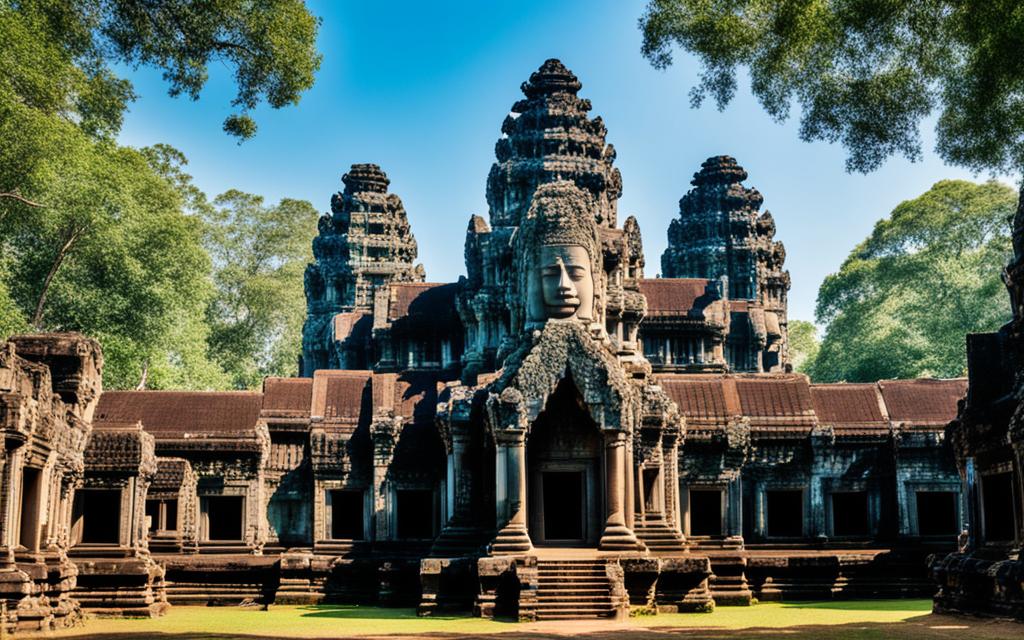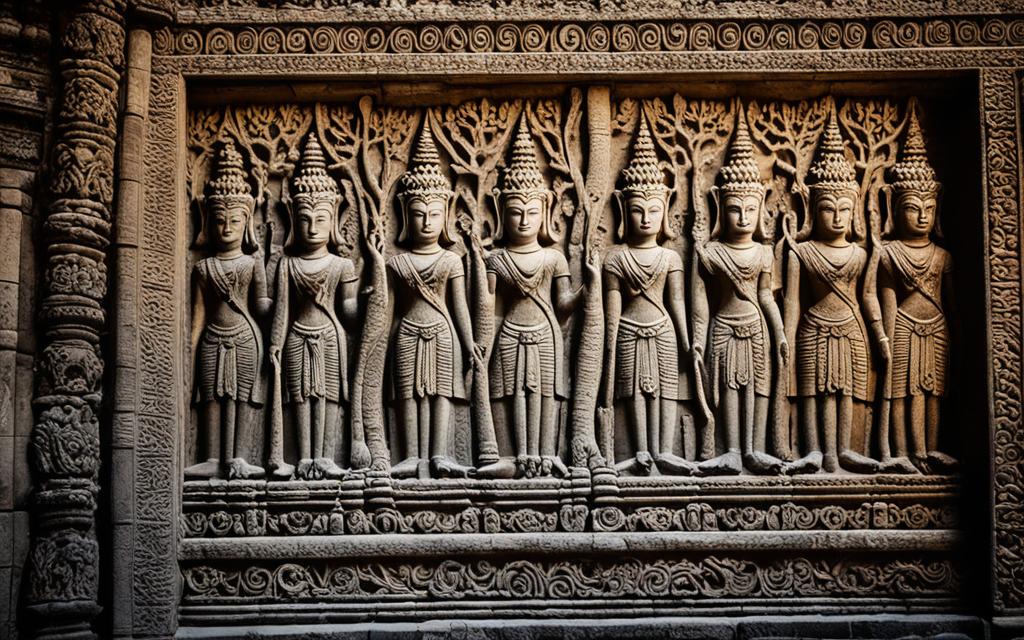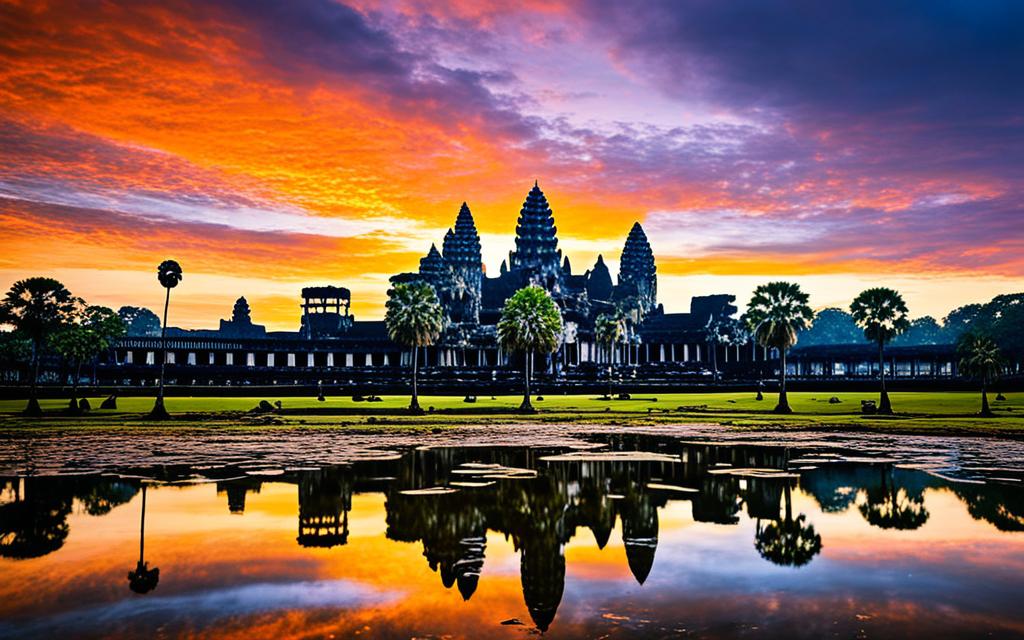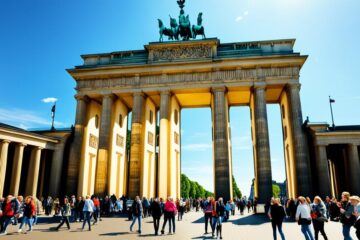As the sun set, it painted Angkor Wat with a warm, golden hue. The massive spires stood against the sky. It was hard not to be amazed by the size and beauty of this ancient treasure. The Angkor Wat complex in Cambodia shows the power and culture of the Khmer Empire.
Angkor Wat covers more than 500 acres, making it the world’s biggest religious site. It is famous for its impressive design, attracting people worldwide. This temple is full of Khmer art and shows their incredible skills. It’s a place where Cambodia’s rich cultural heritage is celebrated. It’s a top spot to see the wonders of the ancient world.
Key Takeaways
- Angkor Wat is the largest religious monument in the world, spanning over 500 acres.
- The temple complex is a stunning example of Khmer architectural and engineering prowess, featuring towering spires, intricate carvings, and serene reflecting pools.
- Angkor Wat is a designated UNESCO World Heritage Site, recognized for its outstanding universal value and cultural significance.
- The temple’s design is rich in symbolism, with the five central towers representing the five peaks of Mount Meru, the mythical home of the Hindu gods.
- Angkor Wat has long been a source of fascination for historians, archaeologists, and travelers alike, drawing visitors from around the world to explore its awe-inspiring wonders.
Angkor Wat: A Marvel of Khmer Architecture
Angkor Wat stands out with five tall sandstone monuments. It covers over 500 acres. Builders didn’t use mortar, only fitting together millions of sandstone blocks perfectly. This shows the Khmer Empire’s incredible architectural prowess.
Intricate Carvings and Bas-Reliefs
The temple’s walls and galleries are covered in detailed intricate carvings and bas-reliefs. These are about Hindu myths and Khmer Empire life. They speak to the amazing work of Khmer craftsmen.
Symbolism and Mythology in the Design
The layout of Angkor Wat is full of symbolism. The five towers symbolize Mount Meru‘s peaks, the gods’ mythical home. Angkor Wat faces west, connects with the sun setting, and Hindu ideas of the afterlife.
Exploring the Iconic Angkor Archaeological Park
Angkor Archaeological Park is famous for Angkor Wat, its top attraction. But it’s also filled with many Khmer monuments and ancient ruins. The Bayon Temple and Ta Prohm are especially fascinating.
The Magnificent Bayon Temple
Located at the heart of the park, the Bayon Temple is a masterpiece. What makes it stand out is the faces on its towers that seem to smile. It’s a unique and peaceful place filled with amazing stone carvings and designs. These show the cultural heritage of the Khmer Empire.
Ta Prohm: Nature’s Embrace
Ta Prohm Temple is very different from Angkor Wat. It shows a beautiful mix of nature with architecture. Its appearance in a movie made it famous as the “Tomb Raider Temple”. Huge tree roots cover the temple’s buildings, creating a magical scene. It reminds us of how powerful nature is and how delicate our structures are, even the grand Khmer monuments.

The Legacy of the Khmer Empire
The Khmer Empire ruled Southeast Asian lands from the 9th to 15th centuries. Its influence spanned from modern Thailand to Vietnam. This empire was known for its advanced building work and water systems.
Angkor, its capital, was then the biggest city in the pre-industrial age, with over 1 million citizens. Over time, the empire faced challenges like war, disease, and environmental issues. These hardships led to its decline.
Yet, the Khmer people’s heritage lives on in their amazing buildings and cultural works, including the famous Angkor Wat.
Angkor Wat: A UNESCO World Heritage Site
In 1992, Angkor Wat became a UNESCO World Heritage site. This status acknowledges its immense value. It also highlights the importance of keeping it safe for the future. Over the years, many projects worked on its upkeep, battling time, the weather, and human damage.
Preservation Efforts
Many steps have been taken to protect Angkor Wat. These include making the structures stronger, removing plants that harm the temple, and careful cleaning and protection of its carvings. The teams dedicated to this work ensure Angkor Wat’s beauty endures for ages.
Responsible Tourism Practices
In line with preserving Angkor Wat, responsible tourism practices were introduced. These aim to keep the site safe while letting people visit. Efforts like visitor number controls, limited access to some parts, and eco-friendly tourism initiatives help find this balance. The goal is to secure Angkor Wat’s richness for the future.

Planning Your Visit to Angkor Wat
Angkor Wat is a top destination for many. With good planning, your visit will be unforgettable. A big decision is choosing the best time to visit this wonder.
Best Time to Visit
The best time is the dry season, from November to April. It’s cooler then and less crowded. You’ll enjoy exploring more. The wet season, from May to October, can be wetter, busier, and unpredictable. This might affect your experience.
Guided Tours and Practical Tips
Guided tours at Angkor Wat help you understand its history and culture. They make sure you see all the important parts. Remember these tips for a great visit:
- Wear comfy clothes and shoes for the uneven terrain.
- Take plenty of water and sun protection to stay safe.
- Respect the local culture and dress and act politely.
With good planning and a sense of adventure, Angkor Wat will leave you amazed. Whether you go alone or on a Siemreap attractions tour, the experience will stay with you forever.
Conclusion
Angkor Wat shows off the engineering and art of the Khmer Empire. With its tall spires, detailed carvings, and deep meaning, it amazes people worldwide. It is a UNESCO World Heritage site, getting special care for the future.
Visiting this amazing temple lets people dive into Cambodia’s history. They see the lasting effect of the Khmer civilization. Exploring Angkor Wat and other ruins in the Angkor Archaeological Park offers a unique look at Southeast Asian history and culture.
The Khmer Empire‘s influence is still seen in their architectural and cultural treasures. Angkor Wat highlights their brilliance. It stands as a symbol of their skill and continues to wow people all around the world.




